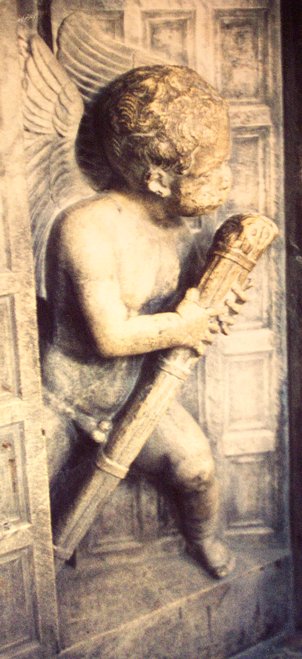English church musicians
The strong (and continuing) tradition of English church choral music produced masses, anthems, and motets from composers who continued to write, despite upheavals in the official religion of England. (Go to the section on religion in the period.) many church composers also wrote music for the Court: thus William Byrd, perhaps the foremost composer of religious music of his time, also wrote dances and settings of popular tunes.
Read about three major Renaissance composers of church music:
Footnotes
-
Thomas Tallis
The earliest of the great English Renaissance church composers, Tallis (c.1505-1585) was organist at the Chapel Royal, a position he later shared with Byrd. Like Byrd, he and his music continued unchanged (except in the language) through the changes under Henry VIII, Edward, Mary, and Elizabeth.
His prolific output of music includes a piece for 40 parts (Spem in alium); his motets for choir a capella are especially distinguished; one was used by the twentieth century compser Ralph Vaughan Williams as the basis for his haunting Variations on a Theme of Thomas Tallis for string orchestra.
-
William Byrd
Perhaps the greatest of English Renaissance composers, William Byrd (1543-1623) was a pupil of Thomas Tallis. He was so highly respected a composer that, though he remained a Roman Catholic in the Protestant reign of Elizabeth, he was permitted to retain his position as organist of the Chapel Royal, and actually wrote masses for the Anglican service. His secular music includes madrigals as well as instrumental pieces for harpsichord and virginal.
His works demonstrate the astonishing beauty and musical sophistication of which Renaissance music was capable.
The examples here:
- The "Gloria" from his Mass for four voices.
- A short dance for harpsichord, "La Volta."
- An electronic recreation of a popular song, "The Carman's Whistle" (© John Sankey, 1999).
-
Orlando Gibbons
Gibbons (1583-1625) took over from Byrd as organist of the Chapel Royal in 1605; in due course he became Court Virginalist (not what you might think -- see below) and organist at Westminster Abbey. As well as composing settings of the English service, anthems, and settings for the psalms, he wrote secular music for the virginal and for viols.
Gibbons is represented in this site CD-ROM not by his church music but by his "Street Cries," a piece that preserves for us the cries of the vendors who crowded Englands' markets.
The virginal
The virginal was a small harpsichord --the jealous Leontes in The Winter's Tale puns on its associations when he watches his wife, Hermione, with his friend Polixenes: "Still virginalling/Upon his palm?" (1.2.125-26).
A secular madrigal by Gibbons is available in a midi file on line.
